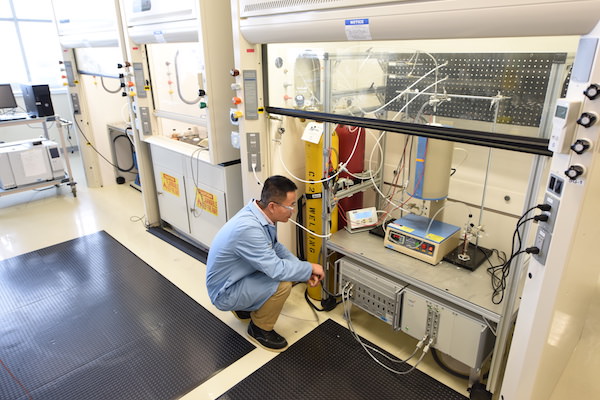
[Image above] Materials engineer Dong Ding improves a direct carbon fuel cell. Credit: Idaho National Laboratory
Fuel cells have been the subject of much research, especially in the age of electric vehicles. We’ve shared research about hydrogen fuel cells here and here. We’ve also reported on solid oxide fuel cell research here and here.
But a newer fuel cell technology that uses carbon as a source of power could provide electricity more cleanly and efficiently. A small research team at Idaho National Laboratory has created a direct carbon fuel cell (DCFC) that operates at low temperatures and has more power density than previous iterations of DCFCs, according to a news story on the INL website.
DCFCs use coal or biomass as their fuel source, but they tend to emit more pollutants, such as greenhouse gas CO2. Also, conventional DCFCs have their limitations between active areas of the cell—the electrode, electrolyte, and carbon fuel source—which result in less effective fuel use, according to the team’s paper.
Older DCFC designs also operate at higher temperatures of 700ºC–900ºC (1,292ºF–1,652ºF), requiring more costly heat-resistant materials.
Idaho National Lab materials engineer Dong Ding and his team created a new and improved DCFC that can use a variety of carbon-based sources, such as coal, organic waste, tar, and biomass—as opposed to hydrogen fuel cells, which rely on a chemical reaction between hydrogen and oxygen—making it much more efficient.
While hydrogen fuel cell technology is considered a more environmentally friendly solution to gas-powered vehicles, because of the cost it may not be practical for use in applications other than specialized industries, such as the military or warehouse operations. And Ding’s team’s improvements don’t require “the energy-intensive step of producing hydrogen,” he explains in the release.
Ding and his team developed the DCFC to operate at temperatures <600ºC (1,112ºF) by making the electrolyte out of doped cerium oxide and carbonate, which maintain performance at low temperatures.
The scientists also created a cloth-like 3-D ceramic anode that connects fiber bundles together to create a larger surface area for chemical reactions. The fuel consists of carbon and carbonate, a fluidic composite that can “easily flow into the interface, increasing the power density” according to Ding in the release. The fuel cells can even be combined and stacked on top of each other based on energy needs.
“In this technology, the solid carbon can readily go through our 3-D ultraporous electrode and reach the interface between electrolyte and electrode, realizing the direct electrochemical oxidation, rather than gasification into carbon monoxide, which is the actual fuel for most direct carbon fuel cells,” postdoctoral researcher Wei Wu, a coauthor of the paper, explains in a video.
Adding carbonate to the carbon fuel increases carbon particle distribution within the fibers, expanding the triple-phase boundaries region—the active area of the cell—which leads to better performance, according to the video.
“The biggest application of this fuel cell technology is for distributed electricity generation due to its high efficiency and environmentally friendly attributes,” Ding writes in an email. He explains it could also be useful for “fully exploiting the potential of carbon wastes and integrating low CO2-emission energy sources.
“Also, the electrode structure illuminated in this technology may have broader applications in a variety of electrochemical systems, such as lithium-ion batteries, supercapacitors, and electrolyzers,” he adds.
Ding and his team are working with a Utah-based energy technology company and have applied for a Department of Energy Small Business Innovation Research-Small Business Technology Transfer Funding Opportunity. “We currently have the technology patent protected,” he adds.
The paper, published in Advanced Materials is “A high-performing direct carbon fuel cell with a 3D architectured anode operated below 600oC” (DOI: 10.1002/adma.201704745).
Watch the video below to learn more about the research.
Credit: Advanced Science News, YouTube
Did you find this article interesting? Subscribe to the Ceramic Tech Today newsletter to continue to read more articles about the latest news in the ceramic and glass industry! Visit this link to get started.
